|
Car Musings: Automotive Thoughts and Opinions (2021 - Part 2)
Rare Supercar Sighting: Recently, we took my wife's Avalon in for some tire work. I spotted a lime green Lamborghini Murciélago LP 640 with a giant silver University of Oregon decal on the hood being hauled into the Battle Ground Les Schwab Tire Center on a flatbed. It needed a new battery - it apparently goes through batteries quite often.

The Lamborghini Murciélago LP 640 was made between 2006-10. It is mid-engined and powered by a 6.5 liter V12 making 631 horsepower.
The service manager told me about the other Lamborghini they service - an Aventador. I was surprised to learn that there are two Lambos in the Battle Ground area.
He said that, if you're a Lambo owner, you need to order tires far in advance. No one stocks them, and they must be factory ordered. He also mentioned that a new gas cap for the Aventador costs $700.
F. Scott Fitzgerald once wrote, "Let me tell you about the very rich. They are different from you and me." Indeed. (posted 8/30/21, permalink)
Why Couldn't Volkswagen Make Something This Cool? Sometimes fakes look better than the real thing and this is Exhibit A:
Check out the steering wheel, which has lots of bright plating and a two-tone color but has a shape reminiscent of the early-60s ivory Beetle wheel.
The paint and chrome trim really set the car off and the interior is clever, glitzy yet somehow Beetlesque. I like it.
If it wasn't made in China, I think the car would be a big success in North America. (posted 8/26/21, permalink)
2040 Is Lookin' Weird: Lincoln has partnered with the ArtCenter College of Design to produce four virtual concept cars as a potential preview of Lincoln design elements.
The cars are set in the world of 2040 ... (more >>>)
Old Paint: A 1920 Ford Model T is owned by W.C. Powelson, a wholesaler and retailer of paints, located at ... (more >>>)
Shipping Fords: This period photograph shows new 1940 Fords being loaded - or unloaded - from boxcars at a freight siding:
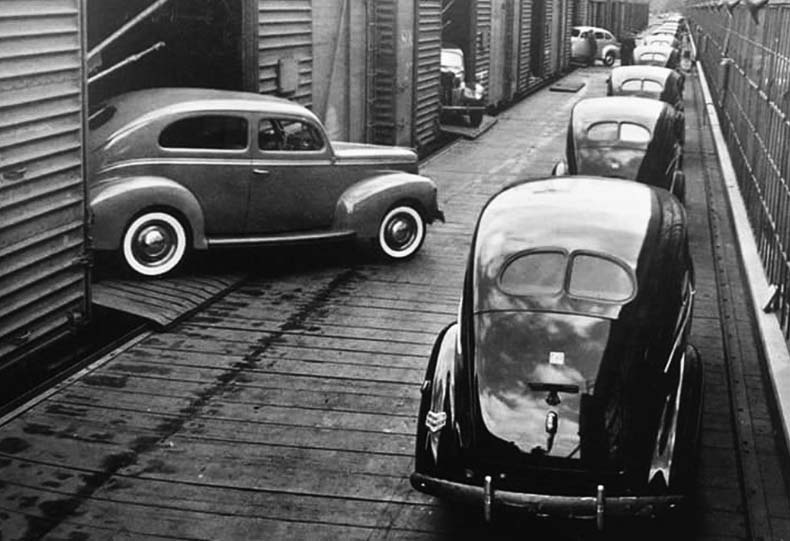
Note that the dark-colored sedan at right has only one taillight on the left side. The Standard model had but a single tail lamp. The Deluxe model had two. The only exceptions were for those two states requiring dual taillights: Washington and Missouri.
Dual taillights became mandatory in 1949 for passenger cars but many trucks had only a single taillight until the mid 1950s. (posted 8/24/21, permalink)
Rolling Design Advertisement: A custom-bodied, streamlined International D-30 delivery truck owned by Teetzel Company Interior Designers is parked outside a residence in Detroit.
The photo was taken in 1937. That's quite a sleek truck for that period.
The new Countach is a cool-looking car and a fine tribute to the original model. However, when the Bertone-designed, mid-engined V-12 powered Countach prototype was unveiled at the 1971 Geneva Motor Show, it was stunning, making other production sports cars of the era look lame by comparison.
In a 16-year period, only 1,983 production examples were produced. Although, during the same period, millions of posters featuring the Countach were sold to teenage auto enthusiasts. Along with millions of Farrah Fawcett posters. It is said that "Countach!" is an Italian expression of surprise and it doesn't translate well into the English language. I took that to mean that it was something like: "Holy shit!" And that's how I often referred to it - the holy-shit-car.
Marcello Gandini penned the original Countach. It's hard to believe that the design is now 50 years old. Mr. Gandini penned many ground-breaking designs, including the Lamborghini Miura, and Diablo as well as the Alfa Romeo Montreal and Carabo, the Lancia Stratos and Stratos HF Zero, the Maserati Quattroporte, the Bugatti EB 110, the Fiat X1/9 and many other eye-catching automobiles.
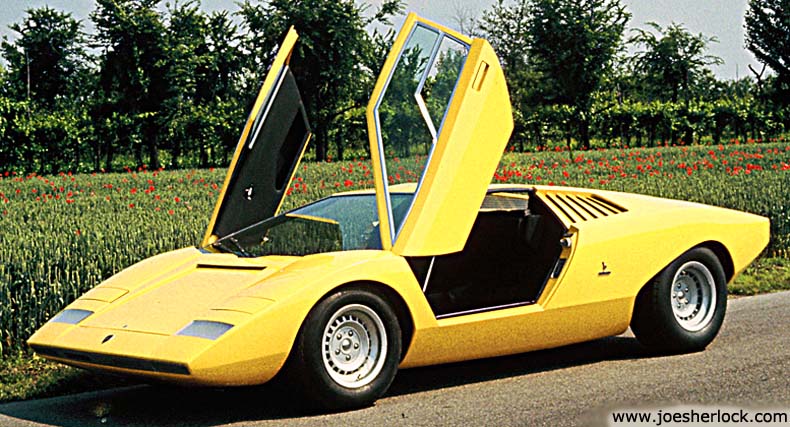
Fifty years-ago, the 1971 Corvette was a really good-looking car, but the Countach made it look old-fashioned. The '71 Ferrari 365 GTB/4 Daytona, while pretty, looked tame next to a Countach. When, my wife and I traveled to Italy in 2002, I saw a couple of used Lamborghini Countaches in a car showroom near Modena.
Fast forward to today. The latest Corvette is a mid-engined stunner, the current Ferrari Roma is clean and gorgeous and the Lamborghini Sián looks like something out of a sci-fi movie. The new Countach is nice enough but it's not the shocker that the original was. The world has caught up to the Countach.
This new-retro Lambo is based on the Lamborghini Sián chassis. Powering the Countach is the Sián's mild-hybrid 6.5-liter V12. It makes 803 horsepower in total, with most of it coming from the engine.
Only 112 of the resurrected Countachs will be built at a price of $2.6MM each. All of them have already been sold. Customers will get their cars in the first quarter of 2022. (posted 8/18/21, permalink)
2021 Monterey Week: Last week's much-anticipated annual car fest offered the usual mix of spectacular and fascinating vehicles on display as well as always-interesting auto auction results. Once simply the Pebble Beach Concours, this car-centric, scenic venue has been expanded to include week-long events, including exclusive new vehicle launches by manufacturers as well as numerous track and rally events. And humongous traffic jams as people try to attend every attraction.
The Monterey auctions concluded Saturday "with a preliminary sales total of $343 million over 3 days - 37% higher than 2019 - despite offering nearly 25% fewer cars. Credit a much better sell-through rate (80% compared to 59%) and higher average price."
With the drop of the gavel, a new record price for a McLaren F1 was established. The official result: $20.465 million dollars, inclusive of fees after a winning bid of $18.6 million.
The metallic Creighton Brown color 1996 McLaren at this Gooding & Company's 2021 Pebble Beach Auction eclipses the previous record of $19.805 million for a 1994 example (and the most recent F1 to cross the auction block) sold at the 2019 RM Sotheby's Monterey sale. The 1996 model had only 242 miles on the odometer. Only 106 examples were produced between 1992 and 1998. In 1993, a new one cost about a million bucks, give or take. I saw one of these in person during our 1995 visit to the Beaulieu Motoring Museum.
At RM Sotheby's a 1962 Aston Martin DB4 GT Zagato Coupe sold for $9,520,000, a left-hand-drive 1965 Aston Martin DB5 convertible earned $3.195 million, a 1963 Ferrari 250 GT Lusso sold for $1,875,000, a 1929 Duesenberg Model J 'Butterfly' Dual-Cowl Phaeton that brought $3,305,000 and a 1957 Mercedes-Benz 300SL Gullwing Coupe sold for $1,352,500.
"A 1959 Ferrari 250 GTO California Long Wheelbase brought $10.84 million at Gooding & Co., and a 1928 Mercedes-Benz 26/120/180 S-Type Supercharged Sports Tourer sold at Bonhams for $5.395 million. 1929 Bugatti Type 35B was sold by Gooding & Company for $5.615 million. A 2012 Lexus LFA Nürburgring rung the bell at $1.6 million, a record for a Japanese road car at auction."
After a China flu-related hiatus in 2020, the Pebble Beach Concours d'Elegance was back in full force, with strong attendance and the always-impressive show field full of perfectly-restored contenders.
A black 1938 Mercedes-Benz 540k Autobahn-Kurier fastback coupe won Best of Show. The extremely rare M-B Autobahn-Kurier was purpose built to suit the newly constructed Autobahn roadway, with a streamlined coupe shape for high-speed cruising.. It is believed that four of this body type were built - two on the 540K chassis - this is the only survivor. Kurier means messenger but a loose translation might be Turnpike Cruiser - shades of Mercury!
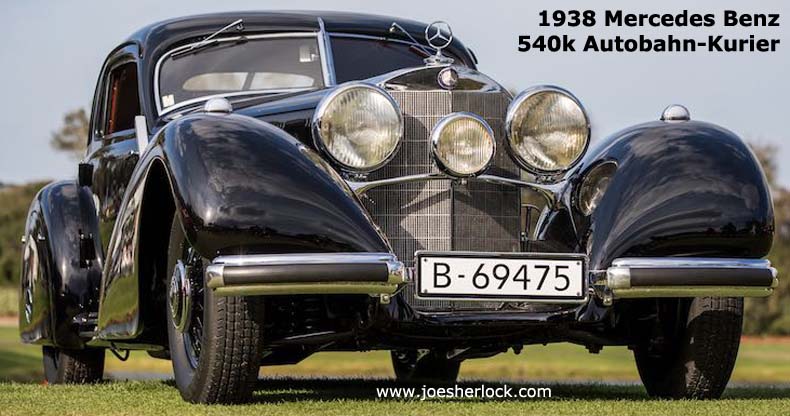
"Owned by Arturo and Deborah Keller, the teardrop-shaped Mercedes was selected from a field of more than 200 cars. The group was first narrowed to 28 class winners and then again to four finalists before the Kurier was announced as the winner. It marks the Kellers' third Best of Show title at Pebble Beach."
This 540K is a multiple concours winner. "It won Best in Show Concours d'Elegance at the 2019 Amelia Island show, Best of Show at the Concours d'Elegance of America in 2011, Best of Show at the Louis Vuitton Classic Concours d'Elegance in 2011, Best of Show at Villa d'Este in 2008, and Best in Class at Pebble Beach in 2006."
As always, Sunday's Pebble Beach Concours was the pinnacle and conclusion of the Monterey Week experience. (posted 8/18/21, permalink)
Early Moving Van: In the days before central air-conditioning and wall-to-wall carpet, it was not uncommon for ... (more >>>)
I Had One Of These ... on the dashboard of my first '39 Plymouth coupe:
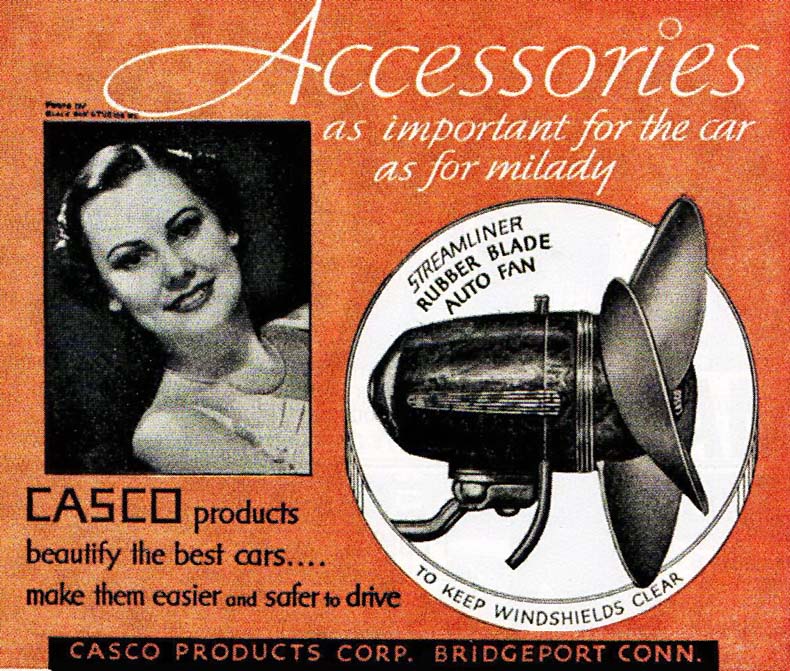
It worked surprisingly well. (posted 8/10/21, permalink)
Book Review: 'Nissan Z - 50 Years of Exhilarating Performance' by Pete Evanow
I reviewed an earlier edition of this book in June 2020. It has now been reworked and updated to include the next generation Z-car, the 2023 Nissan Z. Shown in the book are numerous photographs of the Z Proto, a thinly disguised teaser of the next generation Z-car. The new Z incorporates features and design cues from previous Zs, including a hint of the 240Z's scooped headlight buckets and the 300ZX-inspired rear facia. Overall it is a striking, distinctive and handsome car.
According to Car and Driver, the 2023 Nissan Z will ... (more >>>)
Chop & Drop: Check out this 1950 Lincoln:
Chrome Overload: How can you not like a guy who loves chrome?
Somewhere underneath all that shiny customization resides what appears to be a 1951 Pontiac Chieftan Deluxe convertible coupe. One source identified the Pontiac's owner as entertainer Alvin Cash of 'Alvin Cash and the Registers' and other vocal groups. Alvin was well-known in Chicago's blues clubs for his colorful lavender, pink, and yellow outfits. (posted 7/28/21, permalink)
Small, Decontented And Unsuccessful: This 1952 ad is for the Henry J, a mostly-forgotten small car from the early 1950s:
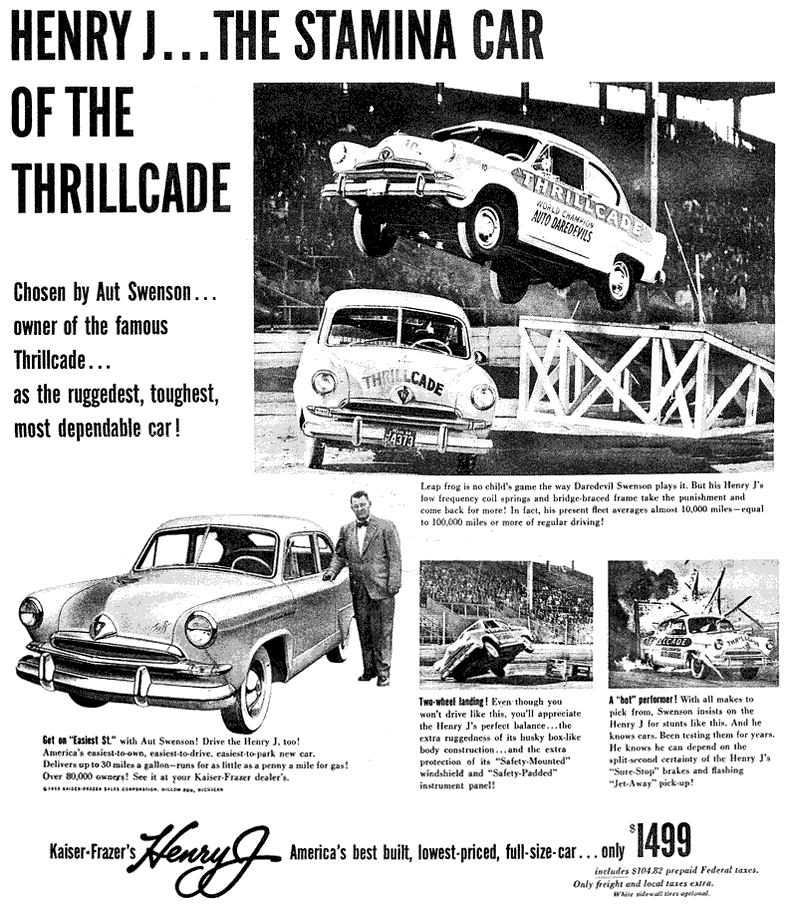
The Henry J was a compact American car built by Kaiser-Frazer Corporation and named after its chairman, industrialist Henry J. Kaiser. The Henry J was introduced as a 1951 model on September 28, 1950.
The car was designed and priced to attract "less affluent buyers who could only afford a used car." The Henry J rode on a 100-inch wheelbase and was 178 inches long. It was relatively light, weighing 2,400 pounds. The base engine was a 68 horsepower flathead four-cylinder. An 80 horsepower flathead inline six was optional. Engines were supplied by Willys-Overland; the 4-cylinder engine was basically the same engine used in the CJ-3A series Jeeps.
To finance its small-car project, the Kaiser-Frazer Corporation received a federal government loan in 1949. This financing specified that Kaiser-Frazer would design a vehicle that in its base form retailed (including federal tax and retail delivery preparation charge) for no more than $1,300. It was to seat at least five adults, be capable of going at least 50 miles per hour for sustained periods of time and available for retail sale no later than September 30, 1950.
To keep the price low, the Henry J was designed to carry the fewest possible components, and built from the fewest parts. To save body stamping costs, early Henry Js did not have rear trunk lids; owners had to access the trunk by folding down the rear seat. Another cost-saving measure was to offer the car only as a two-door sedan with fixed rear windows. Also lacking in the basic version were glove compartment, armrests, passenger-side inside sun visor and flow-through ventilation.
At first, the little Henry J sold well - 81,943 found buyers in the extended 1951 model year. In 1951, the New York Fashion Academy named it "the Fashion Car of the Year." Soon, people realized its shortcomings - the little car was too decontented; buyers could get a well-equipped base-model Chevrolet, Ford or Plymouth for about $200 more. Sales of the compact Nash Rambler were much higher; Nash introduced it in 1950 and positioned the Rambler as a high-content model offering numerous standard features to avoid consumers perceiving it as inferior or substandard.
Henry J sales fell dramatically to 23,500 in 1952, 16,672 in 1953 and 1,123 in 1954. All '54 models were leftover from the 1953 production run and were simply given new VIN plates. (posted 7/26/21, permalink)
Happy Birthday To A Legend: Hot rod pioneer Ed Iskenderian of Isky cams turned 100 this month. He was born to first-generation Armenian immigrants in Tulare County, CA. While at L.A.'s Polytechnic High School, he built a customized Ford Model T.
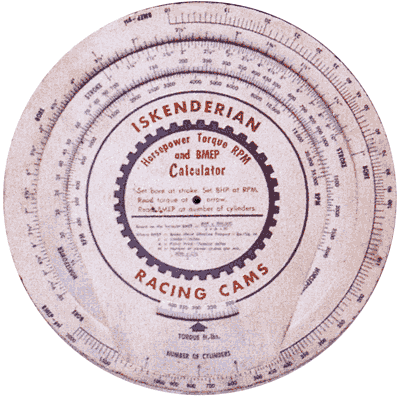
After the serving in the U.S. Army Air Corps in World War II, Iskenderian established a business in a small shop at 5977 Washington Blvd., in Culver City, California; it backed up to Mercury Tool and Die, which was owned by a high school friend of Iskenderian's, John Athan. In this shop, Iskenderian fabricated parts, including camshafts, for fellow hot rodders. He started with a single cam-grinding machine, which he adapted for the purpose himself. Iskenderian's new grinds offered markedly better performance than stock ones. Iskenderian was also the first to offer a hard facing on camshafts.
His camshaft and racing equipment company is still in business. He was one of the founders of SEMA in 1963. In 1985, Iskendarian was named one of Chevrolet's "Legends of Performance." I wish him many more years of good health. (posted 7/26/21, permalink)
Of Bad Sunbirds and Bad Management: Recently, Tom Klockau wrote about a concours-condition 1976 Pontiac Sunbird. He was intrigued by this "corporate sibling to the Chevy Monza Towne Coupe, most of which dissolved by around 1990." The Sunbird was based on the Chevrolet Vega, a fact which explains some of its problems. I guess that, if it's a bad-enough car, it eventually becomes a rarity.
I only knew one guy who owned a '76 Pontiac Sunbird ... (more >>>)
Big Hair; Bright Color: A photo, probably from the latter half of the 1960s, shows how high women's hair had become and how popular orange was as a color.
I have no details about this photo but I guess this gal might be an example of a "trophy wife." (posted 7/22/21, permalink)
Book Review: 'A Man & His Car: Iconic Cars and Stories from the Men Who Love Them' by Matt Hranek
This is a hardcover book in a slipcase, first published in October 2020. The book's apparent objective is to explore the connection between car owners and their rides. It is primarily a photo book, with each vehicle photographed against a black background and a brief explanation about ... (more >>>)
Miracle Motor Tune-Up: Man, this device does everything!
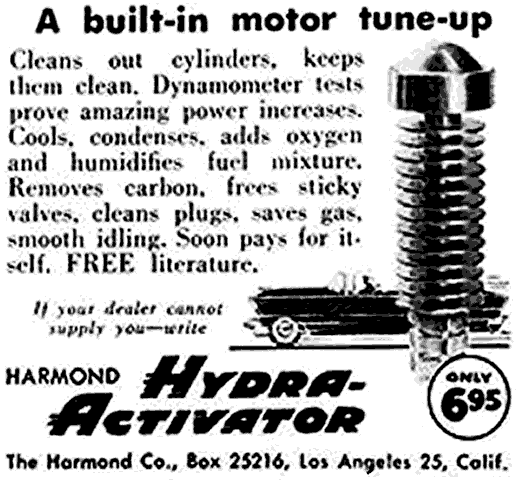
Whatever the Harmond Hydra-Activator was, it didn't cost much in 1955. Search engines have no information on it, so I have no idea how it worked. (posted 7/20/21, permalink)
A Race Car For The Street: On March 4, 1966, Carroll Shelby presented the keys to a Ford GT 40 Mark I Factory Road Coupe to David Heerensperger of Spokane, WA. It was one of only 31 cars built to road specifications. The car was finished in primer, was fitted with a black leather interior and Borrani wire wheels fitted with Goodyear tires. These cars had a base price of $18,250 with A/C available as a $750 option.
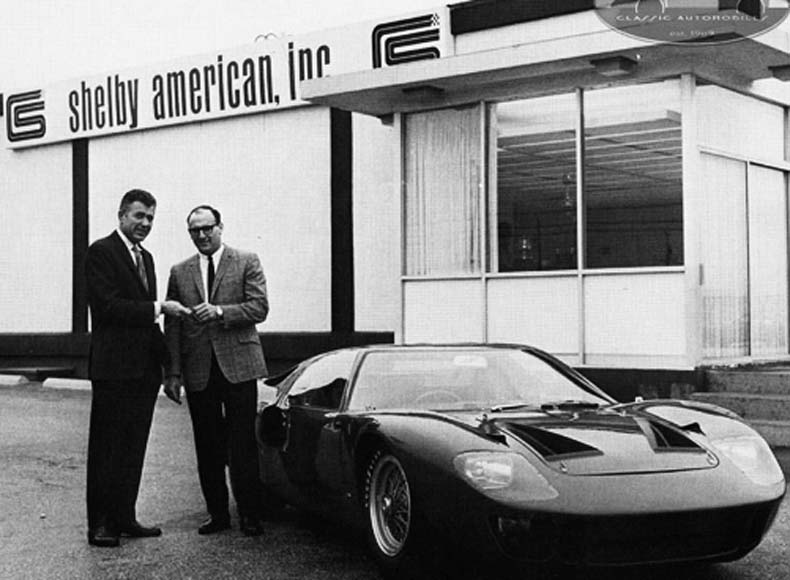
David Heerensperger was a entrepreneur. He owned Pay 'n Pak, a home improvement chain, as well as Eagle Electric & Plumbing in Spokane. He owned/sponsored several hydroplanes and was also an early investor in Emerald Downs. His horse Millennium Wind ran in the 2001 Kentucky Derby.
Mr. Heerensperger oversaw Pay 'n Pak's expansion and grew its annual sales to nearly $400 million before he was forced out in 1989 after an attempted hostile takeover. He went on to create a competitor store, Eagle Hardware and Garden, and Pay 'n Pak shuttered three years later. The company had grown to 32 stores and 6,000 employees by the time Mr. Heerensperger sold it to Lowe's for $1 billion in 1998.
He died at age 82 in 2018. (posted 7/16/21, permalink)
Makin' Sting Rays:
Who knows - one of these '63s could have been the one I owned. (posted 7/14/21, permalink)
I Bet This Added Three Horsepower Or So:
This 1950 ad for Hollywood Tri-Tone tailpipe extensions shows the kind of dress-up stuff you could buy for your car in the good old days. (posted 7/12/21, permalink)
She Must Be Close To Her 100th Birthday By Now:
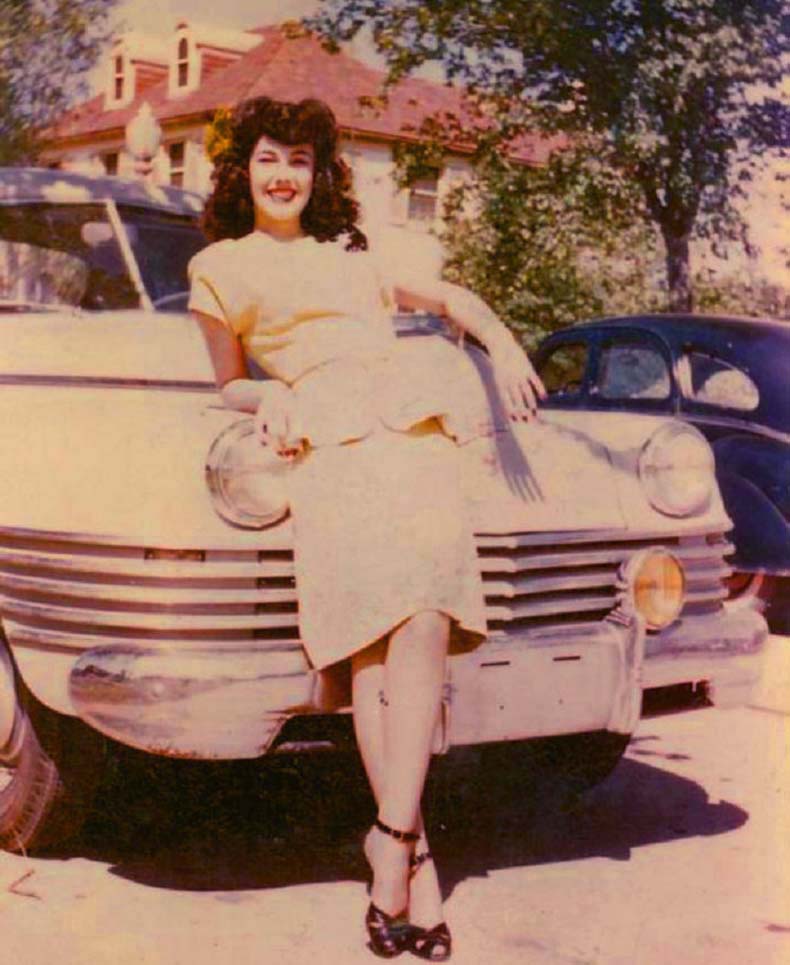
In this period color photo, a cutie poses by a 1942 Chrysler. The front-end design of this car was inspired by Chrysler designer Gil Spear's concept drawing, which gave rise to the distinctive and handsome wraparound grille found on the production 1942 Chrysler. (posted 7/8/21, permalink)
Book Review: 'Volkswagen Type 4: 411 and 412: The Final Rear-Engined VW Cars' by Marc Cranswick
 The Volkswagen Type 4 (411 and 412 models) was VW's attempt to capture the luxury-compact market segment and offer VW's first four-door model, while adhering to VW's traditional air-cooled, rear-engine design. Following the worldwide success of the Beetle, CEO Heinz Nordhoff was looking to expand VW's reach to better, more-profitable markets. But he dithered for more than a decade, commissioning numerous new prototypes and then never greenlighting any of them. One biting industry-insider quip was that the 411, finally introduced in 1968, stood for "four doors, eleven years too late." The Volkswagen Type 4 (411 and 412 models) was VW's attempt to capture the luxury-compact market segment and offer VW's first four-door model, while adhering to VW's traditional air-cooled, rear-engine design. Following the worldwide success of the Beetle, CEO Heinz Nordhoff was looking to expand VW's reach to better, more-profitable markets. But he dithered for more than a decade, commissioning numerous new prototypes and then never greenlighting any of them. One biting industry-insider quip was that the 411, finally introduced in 1968, stood for "four doors, eleven years too late."
In a rapidly-changing automotive landscape (new competition from Japan, an abundance of new American compact car models, rising labor costs in Germany, rampant worldwide inflation, new government pollution and safety regulations), the bland, overpriced Type 4 was an underwhelming offering - a car in search of meaningful context and a market. The ... (more >>>)
Remember Bardahl? Bardahl Corp. was founded in 1939. The company is headquartered in Seattle, WA.
Bardahl's oil additive was advertised during the 1950s in magazines and animated TV commercials which showed the product's effectiveness in combating engine problems such as ... (more >>>)
Cruel Dog Carrier:
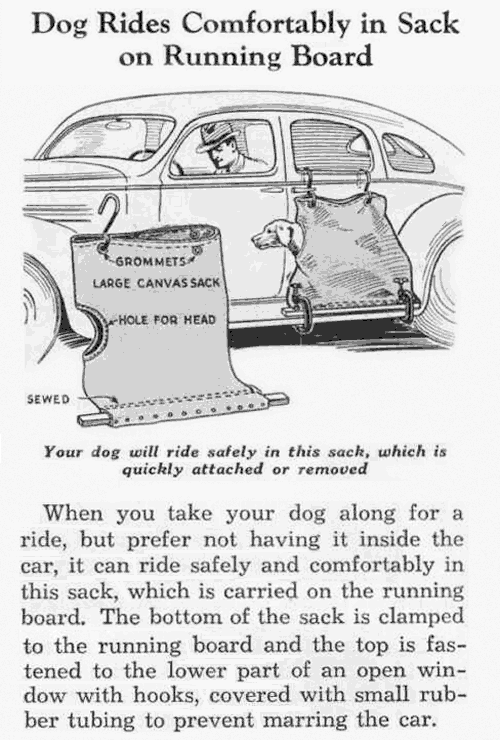
This thing was probably invented by Mitt Romney. Or Cruella de Vil. (posted 6/29/21, permalink)
Cal Custom tries for Peter Max style graphics in the late 1960s. (posted 6/25/21, permalink)
A Little Over 75 Years Ago: This is what General Motors designers though that cars would look like in the 1950s:
All teardrops, lotsa glass, perhaps a center tailfin. (posted 6/23/21, permalink)
Wanna Drag? Well known to Philadelphia and South Jersey car enthusiasts, the Atco Dragway opened in 1960. Some events have drawn thousands of spectators to this sleepy Camden County ... (more >>>)
Sleek Gift: For Father's Day, I received a resin-cast 1:43 scale model of a 1953 Pegaso Z-102 2.5 Cupola Coupe made for Matrix Models (a Netherlands company) in China. The model has photoetched detail components and run size was limited to 408 examples.
The Pegaso Z-102 was a limited-production Spanish sports car produced by ... (more >>>)
Do It Yourself: This Build Your Own Motor Car ad is from September 1947:
Such small ads were often found in period magazines such as Popular Mechanics and Mechanix Illustrated. (posted 6/21/21, permalink)
Give Your Car That Jet Look:
Remembering The Hirohata Mercury: It was one of the most famous early 1950s customs. Road & Track did a nice photo spread of this iconic Merc.
"In 1952, after a stint in the U.S. Navy, Bob Hirohata took a '51 Mercury Club Coupe and a blank check to Barris Kustoms. The Barris brothers massaged and smoothed every panel, chopping the top four inches in front, seven in the back, completely altering the car's silhouette. They reshaped the body sides and elongated the fenders. The headlights were Ford, the taillights were Lincoln, the chrome trim was Buick. Chevrolet teeth sparkled in the fender vents." (posted 6/17/21, permalink)
When Stock Isn't Quick Enough: Movie star and car guy Clark Gable picks up his 1955 T-Bird after having a McCulloch supercharger installed.
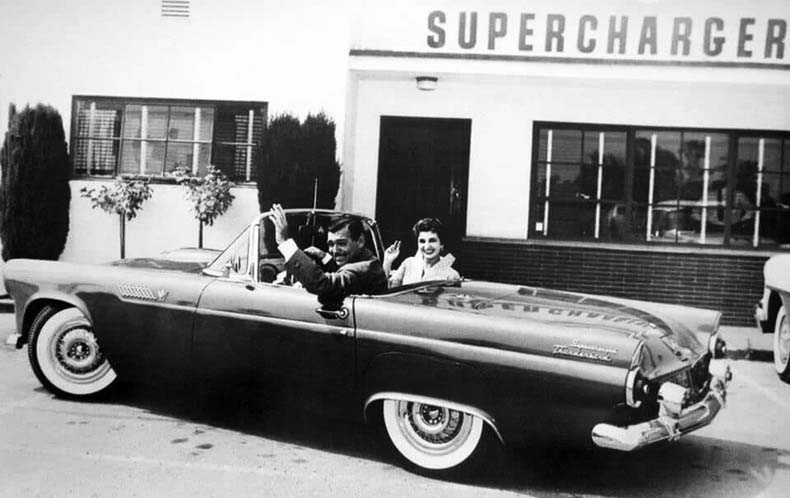
Note the chrome script 'Supercharged' on the rear fender just above the Thunderbird script. (posted 6/15/21, permalink)
Too Many Companies, Too Many Brands: Big technological change finds companies flocking to cash in. But, usually there's not enough room for all of them and many just go out of business. This has happened twice before in the automotive business and it's happening again with the new technology of electric vehicles.

In the early days of the 20th Century, there were many companies which raised capital, built a few cars, couldn't compete or make money in a market that had fast-moving technology and consolidation of suppliers dealers and manufacturers. Some were just scammobiles conceived to sucker money out of investors. If you're a car guy with total recall, you may remember long-gone car names such as Abbott, Hayes-Apperson, Duryea, Emancipator, Grout Runabout, Orient Buckboard, Metz, Ultra Motorcar and others. In the early 20th Century, there was no Big Three. Instead, there was the Sorta-Big One Hundred And Three. Or maybe more.
Immediately after the end of World War II, there were lots of companies with employees, metal-bending as well as machining equipment and no business. Several decided to get into the car biz: Kaiser, Frazer, Tucker, Beechcraft, Keller, Davis, Brogan Doodlebug, Bobbi-Kar, Del Mar, Fageol, Playboy, Towne Shopper, Gregory as well as Hoppenstand and others. None survived the 1950s.
Now there are new companies making Battery Electric Vehicles, including Nikola, Fisker, Lordstown Motors, Lucid Motors, Workhorse, Rivian and others. That's just in the U.S. The delivery van business includes contenders such as Arrival, Canoo, Xos, E-Ducato and Electric Last Mile Inc. (ELMS). Lordstown Motors, which is attempting to launch an electric pickup truck, is running out of money.
In its most-recent SEC filing, Lordstown stated, "Our ability to continue as a going concern is dependent on our ability to complete the development of our electric vehicles, obtain regulatory approval, begin commercial scale production and launch the sale of such vehicles. We believe that our current level of cash and cash equivalents are not sufficient to fund commercial scale production and the launch of sale of such vehicles."
China now has 846 carmakers "More than 300 of those churn out new-energy cars, with everyone from smartphone makers to property developers piling in. One of the main reasons for this is Beijing, which has made dominating the brave new automotive era a top priority, a message heard loud and clear by the thousands of cities and provincial governments that implement policy throughout the vast country." (posted 6/11/21, permalink)
Mr. Paint: Born in 1908, Earl Scheib never went to college. Instead, he got a job as a gas station attendant changing oil and tires for General Petroleum Co. in the late 1920s. Not long after, he went into business with his own gas station on the corner of Whitworth and Fairfax in Los Angeles. His neighbors soon began asking if he knew anyone who could paint their cars. So, each night, after closing time, Earl would paint cars in the station's lube garage.
It didn't take long for word of Earl's painting service to spread, and soon ... (more >>>)
I guess the cut-down door on that hot rod was padded in red leatherette for a reason. (posted 6/7/21, permalink)
Royal Imperial: In 1953, Chrysler created a one-off Chrysler Imperial show car to celebrate the coronation of England's Queen Elizabeth II.
It was never presented to the queen, it was simply a show car built to promote the Chrysler brand. (posted 6/3/21, permalink)
Mr. Peanut Goes For A Ride: An early Planters Peanutmobile in College Hill, Ohio - 1929:
College Hill is located about 10 miles north of downtown Cincinnati. I posted a lot more information about Mr. Peanut and Planters here. (posted 6/1/21, permalink)
Why Is This Car So Unhappy? Behold the face of the sad-looking 2022 Mini in the photo at left:
Photo at right: There, I fixed it. (posted 5/28/21, permalink)
It Pays To Advertise: Whether you're selling Oldsmobiles or religion, a billboard will increase recognition. The top billboard was painted ... (more >>>)
Surprise Car Sightings: Last Thursday, my wife and I went to the public library in Battle Ground Village to pick up some books. On the way home, we passed a bunch of interesting vehicles, parked along a normally-deserted SE Commerce Avenue. I parked our Lexus nearby and walked over to get a better look.
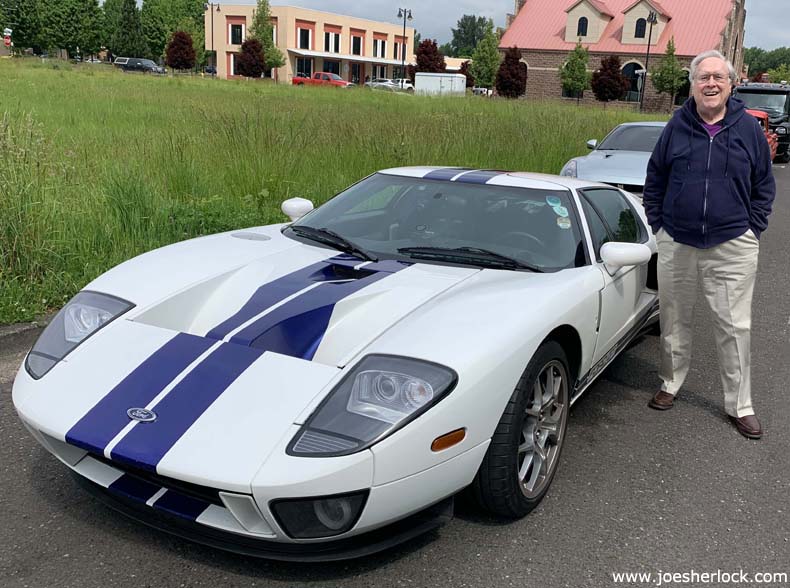
The first vehicle that caught my eye was a white 2005-06 Ford GT with blue racing stripes - the supercar with the mid-engine V8 (only about 4,000 were produced). It had Illinois plates. Ford produced the mid-engined two-seater GT sports car for the 2005 and '06 model years. The styling was inspired by the Ford GT-40 race cars of the 1960s although the GT was larger in size in order to accommodate larger people. The supercharged V8 engine produced 550 horsepower and was mated to a six-speed manual transmission. The GT was priced at $149,995 but dealers added as much as $100,000 extra mark-up because of high initial demand. They are seen less often around here than a Higgs boson particle and sell for $250-350,000 at auction these days.
Behind the Ford GT was a silver Nissan GT-R (also with Illinois plates) and other expensive, exotic cars. Other cars wore Arizona and other out-of-state plates as well, including a tricked-out, recent-vintage black Mustang convertible with Arizona plates.
A fellow who was taking photos of the cars said that the vehicles were driven from their home states to a "big art show" at Treasure Investments gallery, specializing in limited-edition sculptures. He said that some of the art was auto-themed. He couldn't (or wouldn't) offer much other information except that the showroom was "full of billionaires." I'm not sure why wealthy art collectors would travel long distances by exotic - and probably fairly uncomfortable - cars. Why not drive a plush Bentley instead? Or fly in on a private jet? I can offer no obvious explanation. But then, Occam's razor couldn't shave a single hair on my face.
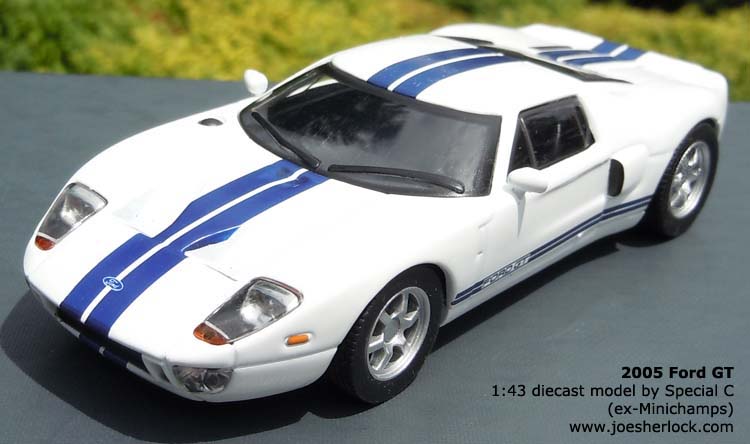
I have a 1:43 scale model of a Ford GT in the same color combo as the one I saw last week. My model was a Father's Day gift in 2014 and cost less than eight bucks. (posted 5/26/21, permalink)
Disguise: Here are photos of a Corvair test mule on the road in 1958:

This fooled some of the car mags of the period; their artists produced sketches of the upcoming 1960 Corvair based on these photos. Note that the mule is equipped with a front grille to misdirect onlookers into thinking this was some kind of front-engined car. The mule also wore fake badges, possibly Vauxhall or Holden. (posted 5/26/21, permalink)
Big Fins And Other Protuberances: As seen on this new '57 Dodge displayed at a car show:
And this '58 De Soto Fireflite convertible:
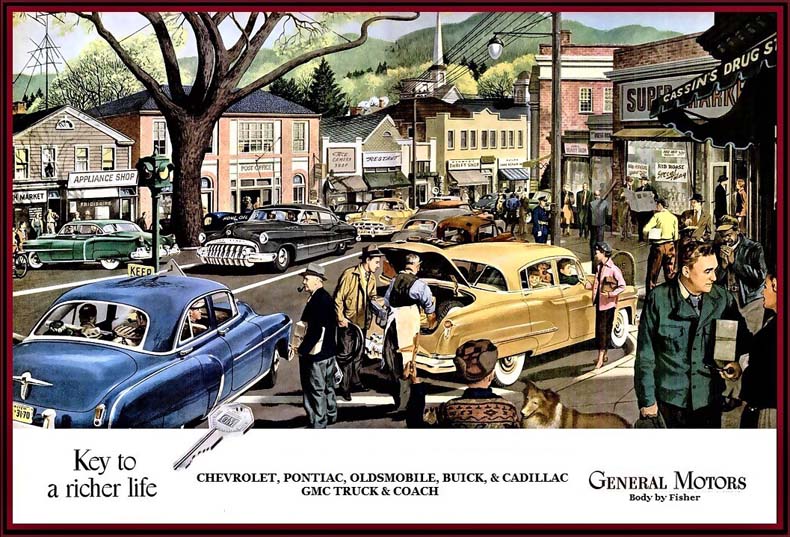
In 1950, General Motors held 45.7% of total U.S. automotive sales. GM's share of the U.S. market has decreased dramatically since its peak of 52.2% in 1962, falling to 17.3% of the U.S. market in 2020. (posted 5/20/21, permalink)
Book Review: 'Ford Model T, An Enthusiast's Guide - 1908 to 1927 (all models and variants)' by Chas Parker (with Chris Barker, Neil Tuckett and others)
Before the Ford Model T, cars were mere playthings for the rich. Henry's T didn't just put America on wheels, it put the world on wheels. The Model T was the first truly affordable car for the working man. Initially priced at $850 in 1908, the price dropped to $390 by 1914 due to production efficiencies. By 1927 a new Model T could be had for as little as $260. At its peak popularity, 1.25 million Model Ts were sold each year. By 1918, Ford's American market share was an astonishing 49%, while 40% of the cars on British roads were Ts. By 1921, the Model T commanded 60% of the new car market around the world. Over 15 million Model T Fords were eventually produced.

Auto scribe/engineer/philosopher L. J. K. Setright wrote, "So profound was the effect of the Model T Ford on America, so much did it change the nature of the nation … its art, its music, its social structure …, that Henry Ford, who was responsible for it all, must be seen as the most effective revolutionary." The Model T tops ... (more >>>)
Earlier Car Musings can be found here.
Other Pages Of Interest
| blog: 'The View Through The Windshield' |
| greatest hits: index of essays & articles | blog archives | '39 Plymouth |
| model train layout | about me | about the blog | e-mail |
copyright 2021 - Joseph M. Sherlock - All applicable rights reserved
Disclaimer
The facts presented on this website are based on my best guesses and my substantially faulty geezer memory. The opinions expressed herein are strictly those of the author and are protected by the U.S. Constitution. Probably.
If I have slandered any brands of automobiles, either expressly or inadvertently, they're most likely crap cars and deserve it. Automobile manufacturers should be aware that they always have the option of trying to change my mind by providing me with vehicles to test drive. I'll dutifully report my road test impressions on this car blog.
If I have slandered any people or corporations, either expressly or inadvertently, they should buy me strong drinks (and an expensive meal) and try to prove to me that they're not the jerks I've portrayed them to be. If you're buying, I'm willing to listen.
|